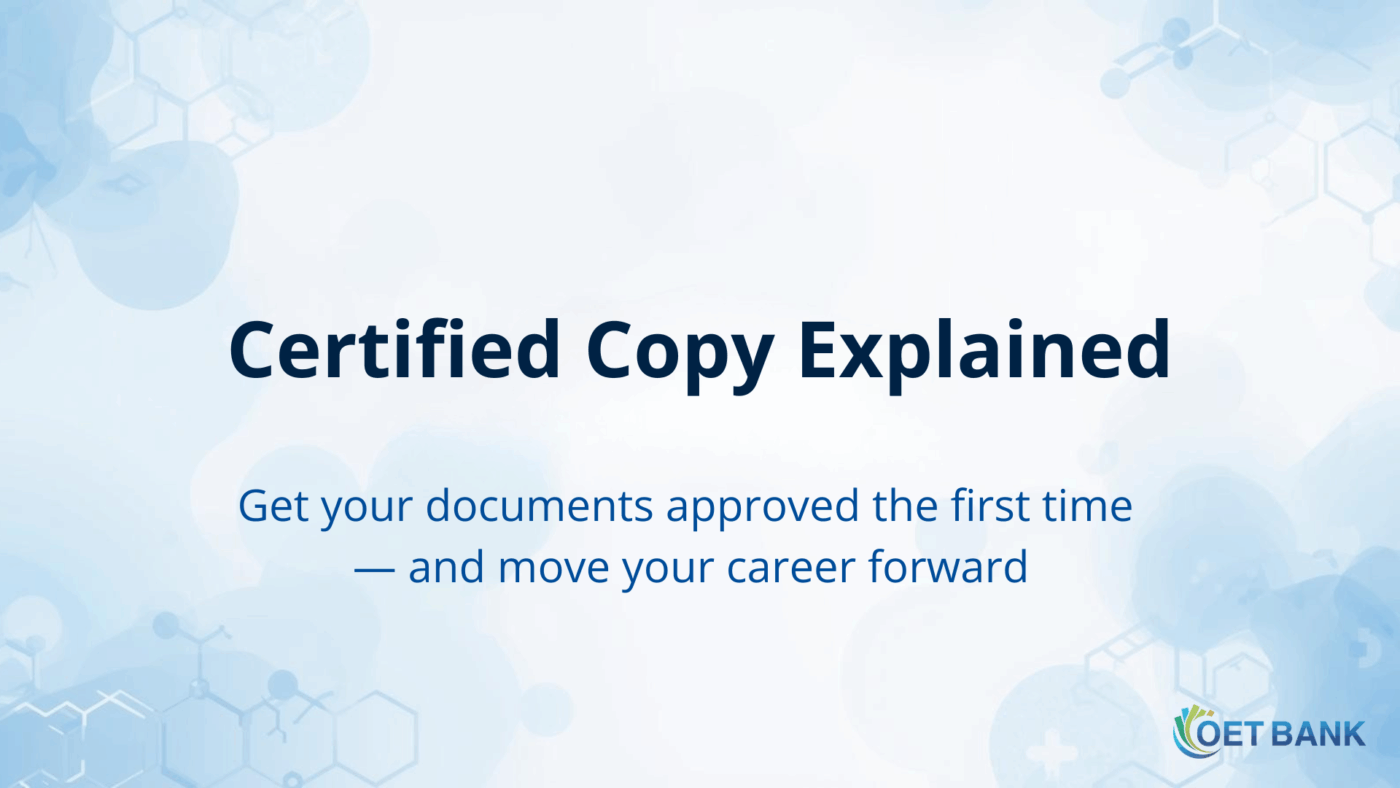Registration & Pathways
Certified Copy – A Global Guide for International Nurses
When applying for overseas nursing registration — whether in Australia, Ireland, the UK, Canada, or the Middle East — one of the most common document requirements is a certified copy.
For many internationally educated nurses, this step can be confusing.
What exactly is a certified copy?
Who can certify your documents?
And how can you make sure your copies are accepted the first time you submit them?
Here’s a simple, practical guide that applies no matter where you live or where you plan to work.
What Is a Certified Copy?
A certified copy is a photocopy of an original document that has been officially verified as a true and exact copy of the original.
This verification must be completed by an authorized professional, not by the applicant.
Typical documents that require certified copies include:
- Passport identification page
- Nursing registration certificate or license
- Degree or diploma certificate
- Academic transcript
- English test results (OET, IELTS, TOEFL)
Regulators require certified copies so they can confirm the authenticity of your documents without handling the originals.
Who Can Certify Your Documents?
Each country has its own rules, but most nursing authorities accept certification from professionals such as:
- Notary Public
- Lawyer / Solicitor
- Justice of the Peace
- Commissioner for Oaths
- Peace Commissioner (in Ireland)
- Authorized embassy or consular officer
If you’re living abroad, you can usually visit a notary public, a law firm, or your embassy or consulate to get documents certified.
The key is to ensure the certifier has legal authority to verify documents in your country.
What Must Be Written on the Certified Copy
Every certified copy should contain the following six elements, ideally on each page of the document:
- The certifier’s signature
- The certifier’s full name
- The certifier’s title or profession (e.g., Notary Public, Lawyer)
- The date of certification
- An official stamp or seal
- A statement confirming comparison with the original, such as: “I certify this is a true copy of the original document I have seen.”
💡 Tip: If your transcript or syllabus runs over several pages, each page should carry at least a signature or stamp to show it was individually verified.
How to Get Your Documents Certified
Depending on where you live, you have several options:
✅ Option 1: Notary Public
A notary public is one of the most widely accepted certifiers.
You’ll need to bring your original document and a copy. The notary will compare them, sign, and stamp the copy as a “true copy.”
Notarial offices or private notaries are available in most countries, including those in Asia, Africa, and the Middle East.
✅ Option 2: Lawyer or Solicitor
A lawyer can also certify your documents.
This option is particularly useful if you need the certification written in English, since lawyers can include a statement such as:
“Certified to be a true copy of the original seen by me.”
Make sure the lawyer includes their name, signature, profession, date, and office stamp.
✅ Option 3: Embassy or Consulate
If you are living overseas, your home country’s embassy or consulate may provide document certification services.
This is often accepted for regulatory and visa-related submissions, especially if you’re applying for recognition or registration abroad.
Language and Translation Requirements
If your certification or documents are written in a language other than English, most nursing regulators require a certified English translation.
The translation must include:
- The translator’s name, signature, date, and contact details
- A declaration confirming it is a complete and accurate translation
Even if your notary statement is written in another language, attaching a certified English translation prevents delays or rejections.
Five-Point Checklist Before Submission
✅ The copy was made directly from the original (not another copy)
✅ Each page shows the signature, date, title, and stamp of the certifier
✅ The certification statement is in English (or accompanied by a translation)
✅ Scanned copies are clear, color, and high-resolution
✅ File names are descriptive and professional, e.g.
Certified true copy of Passport – notarised in [country name]
Global Standards at a Glance
Although every board (AHPRA, NMBI, CNO, NMC, DHA, etc.) has its own documentation checklist, the core principles remain the same worldwide:
- Certified by an authorized professional (Notary or Lawyer)
- Clearly states “true copy of the original”
- Includes signature, date, title, and stamp
- English version or certified translation provided
Once you’ve prepared your documents in this format, your certified copies will be recognized by most international regulatory bodies — wherever your nursing career takes you.
Study with OET BANK
Stop wasting time comparing OET materials.
With OET BANK, you get:
- Premium-quality OET materials, built by professionals
- A focused, efficient study path — no unnecessary content
- A system designed to help you pass OET once — without trial and error
If you want to prepare properly and pass with confidence,
you don’t need to look anywhere else.
Pick your materials and start today — with OET BANK.




